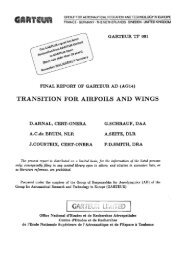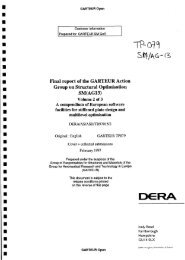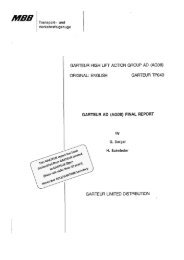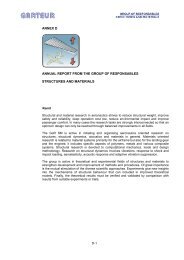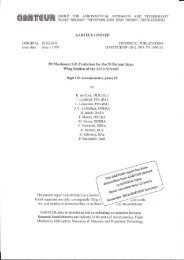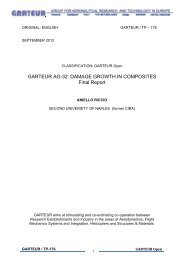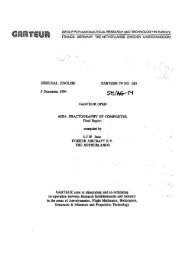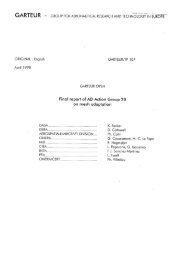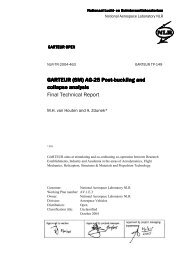Cadmium Substitution - garteur
Cadmium Substitution - garteur
Cadmium Substitution - garteur
Create successful ePaper yourself
Turn your PDF publications into a flip-book with our unique Google optimized e-Paper software.
GARTEUR LIMITED<br />
A.2.4<br />
Delta-tone/Delta seal<br />
Coatings were applied by Ewald Dörken AG but detailed information about the process is<br />
not available. The complete protective scheme, Delta-Magni, consists of two coatings; a<br />
thin layer containing zinc flakes known as Delta-Tone and an organic coating<br />
incorporating a lubricant and marketed as Delta-Seal. Literature produced by the<br />
company indicates that the coatings are applied by dip-spin, dip drain or spray. After<br />
application the Delta-Tone coating is cured at a temperature of approximately 200 o C. To<br />
increase the corrosion resistance of the coating and improve the frictional properties a<br />
coating of Delta-Seal is applied. This is an organic topcoat, which contains a lubricant<br />
and is also cured at relatively low temperatures.<br />
A.2.5<br />
Electrodeposited aluminium<br />
The electrodeposition of aluminium by the Galvano-Aluminium process is carried out in<br />
an organic bath consisting of aluminium-alkyl complex solutions. The process allows<br />
aluminium to be deposited directly onto a steel substrate unlike earlier processes which<br />
required the use of a copper or nickel intermediate layer. The various stages in the<br />
plating process are detailed in table A8.<br />
The bath parameters employed are given in table A9.<br />
A.2.6<br />
PVD aluminium coatings<br />
Aluminium coated panels and fasteners prepared by physical vapour deposition were<br />
supplied by Aerocoat. The deposition process was carried out in accordance with<br />
Defence Standard 03-28(Part 1). Details of the procedure used are given in table A10.<br />
A.2.7<br />
Unbalanced magnetron sputtered aluminium - magnesium coatings<br />
Aluminium - magnesium coatings were deposited using an unbalanced magnetron<br />
sputtering technique operated at Salford University. The test panels were initially<br />
degreased using an ultrasonic bath containing alcohol and then placed in the vacuum<br />
chamber. The magnetron sputtering chamber was evacuated to 10 -5 Torr or below and<br />
then backfilled with high purity argon to a pressure of around 5x10 -3 Torr. The chamber<br />
contained two consumable targets, one commercial grade aluminium (99.4% purity) and<br />
one of commercial grade magnesium (99.5% purity) Prior to deposition, the steel test<br />
panels were sputter cleaned, typically at an applied voltage of 1 kV for 30minutes to<br />
remove any traces of surface contamination.<br />
Following this high voltage sputter cleaning process, a low-voltage was applied to the<br />
test panels, typically -50V (DC) to provide an external bias during deposition. The targets<br />
were energised using an electrical current to typical power levels of 3kW for an<br />
aluminium target and 1.5 kW for magnesium target. The coating process was continued<br />
for a sufficient time to allow the required thickness of deposit to build up on the<br />
substrates. After the desired thickness had been obtained, the deposition process was<br />
halted and the coupons allowed to cool under vacuum to prevent oxidation. A typical<br />
deposition rate was 0.3μm min -1 . Further information on the unbalanced magnetron<br />
sputtering of aluminium - magnesium coatings is given in references A2 and A3.<br />
A.2.8<br />
Electrodeposited cadmium coatings<br />
Panels and fasteners were coated using a standard cyanide electroplating bath operated<br />
in accordance with Defence Standard 03-19 [A4].<br />
Page 40<br />
GARTEUR SM/AG17 TP128




